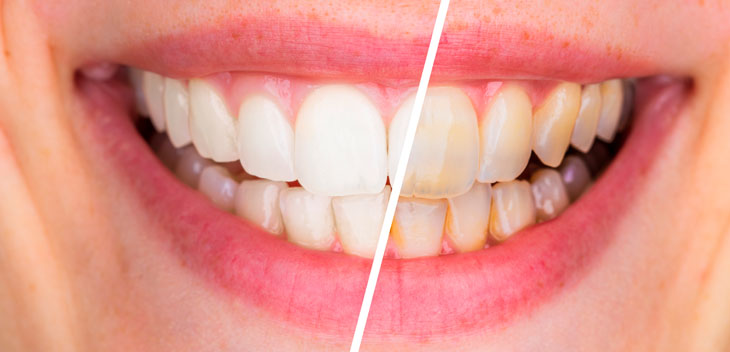You know what’s not so black and white, teeth whitening. Anyone who has ever considered doing a little something extra for a brighter smile will tell you, there are a number of things to consider. For example, can teeth whitening only be done at the dentists? How long can I expect it to last? What’s used to whiten the teeth? And most importantly, is teeth whitening safe?
 Keeping It Natural
Keeping It Natural
If you’re someone who prefers to try the more holistic approach, there are some safe natural teeth- whitening methods, including using baking soda (with apple cider vinegar or strawberries), eating pineapple and oil pulling. Oil pulling is simply swishing coconut oil through your teeth to take advantage of the oil’s antimicrobial properties, thus helping to protect and clean your gums as well as prevent disease.
While there’s no proof that any of these practices remove stains 100%, they’re all safe natural teeth-whitening methods with little to no side effects. So, if you’ve got some of the ingredients around the house you don’t have anything to lose by trying them out.
DIY? or Why Not?
There are plenty of options to consider if you prefer to keep your teeth whitening close to home. Probably the easiest step you can take is just swapping out your regular toothpaste and mouthwash for a whitening variety, which can help to lighten stains with regular use. Beyond that, home whitening kits come in a variety of forms, from pens, to strip, and complete mouth guard kits. And, depending on the kits’ ingredients and brand, you’re probably able to pick one up at your grocery store or drugstore.
However, while home kits are affordable and easily accessible, most don’t contain enough active ingredients to effectively lift stains from the teeth. In fact, legally, these products have to contain less than 10% of carbamide peroxide and no more than 3.5% of hydrogen peroxide, the most common teeth whitening bleaches. Additionally, when using a home mouth guard kit, it’s possible to have gel spillage onto your gums, which can cause irritation and blisters.
So, if you’re looking to try whitening your teeth at home, your best bet is visiting your dentist first to make sure that teeth whitening is the right option for you. And then, once you receive your dentist’s okay, be sure and complete a dental checkup and cleaning so you can be sure and start to whiten your teeth on a clean slate.
Leaving It to the Professionals
Teeth whitening done at your dentist’s office is the safest way to see results. There are two options to choose from. Professional bleaching involves the dentist creating a mold of your teeth, then using a gel inside the mold to whiten them. Laser whitening is more expensive, but it produces a better result by painting powder bleach onto your teeth and then using lasers to activate the whitening process.
Compared to the lower concentration of active ingredients in home kits, dentists can use up to 25 - 40% of hydrogen peroxide, achieving a much faster and more brilliant result. Usually, teeth whitening at the dentist requires only one session where the bleach is left on for 15-30 minutes, although it’s possible to have up to three sessions (spread over a longer period of time) to achieve maximum whiteness.
Due to the higher concentration of hydrogen peroxide, dental whitening also raises the risk of gum irritation. However, if you’re getting your teeth whitened at the dentist, he or she will use a rubber dam to protect your gums, and the dentist is trained to notice any irritation and treat it quickly.
For those with sensitive teeth, a pre-treatment of fluoride can help strengthen teeth before bleaching, and potassium nitrate can aid in calming the nerves in the teeth to create a more comfortable whitening experience. Again, these are all services that are unique to the dentist, so for the safest method with the best results, dental teeth whitening is a clear winner.
Is Teeth Whitening Safe?
Still wondering if teeth whitening is safe? Before committing to making your pearly whites pearlier and whiter, when done at the dentist you can be rest assured teeth whitening is considered safe. However, when done improperly and without medical advice, tooth and gum sensitivity can occur. These effects are often short-term and treatable, with no long-term effects being recorded as of yet. When used in a proper environment, teeth whitening can be a safe way to help you achieve the smile you’ve always wanted.

